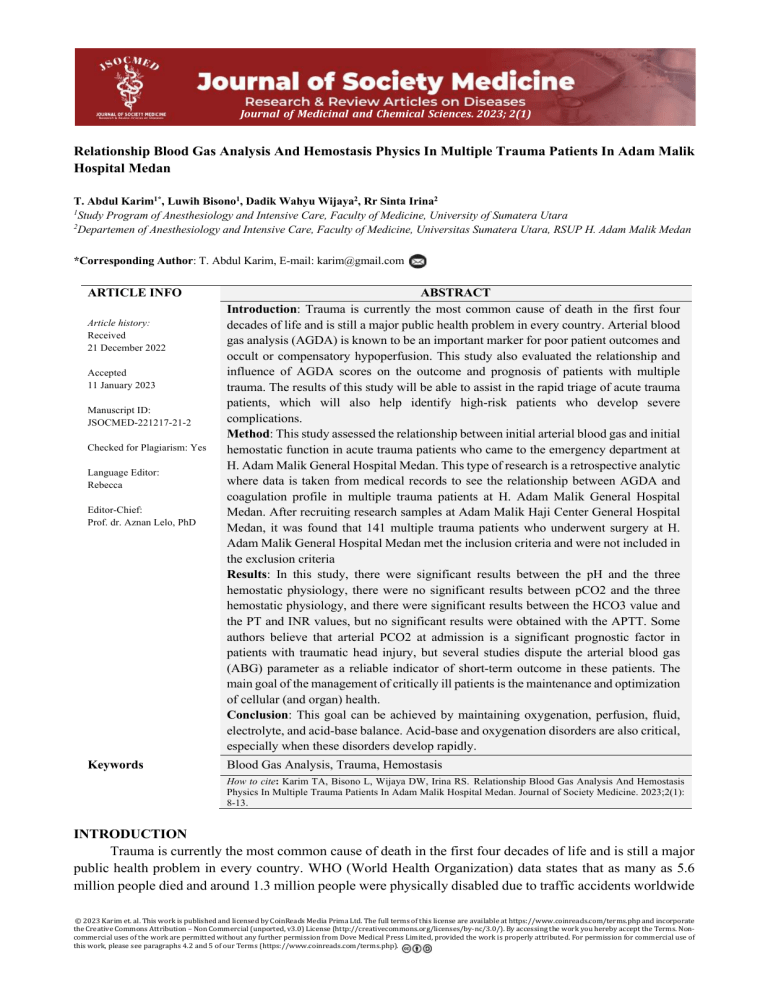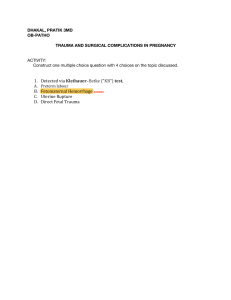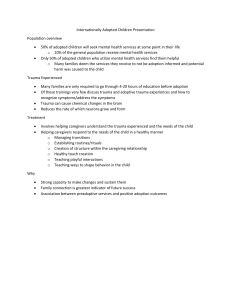
Journal of Medicinal and Chemical Sciences. 2023; 2(1) Relationship Blood Gas Analysis And Hemostasis Physics In Multiple Trauma Patients In Adam Malik Hospital Medan T. Abdul Karim1*, Luwih Bisono1, Dadik Wahyu Wijaya2, Rr Sinta Irina2 1 Study Program of Anesthesiology and Intensive Care, Faculty of Medicine, University of Sumatera Utara 2 Departemen of Anesthesiology and Intensive Care, Faculty of Medicine, Universitas Sumatera Utara, RSUP H. Adam Malik Medan *Corresponding Author: T. Abdul Karim, E-mail: karim@gmail.com ARTICLE INFO Editor-Chief: Prof. dr. Aznan Lelo, PhD ABSTRACT Introduction: Trauma is currently the most common cause of death in the first four decades of life and is still a major public health problem in every country. Arterial blood gas analysis (AGDA) is known to be an important marker for poor patient outcomes and occult or compensatory hypoperfusion. This study also evaluated the relationship and influence of AGDA scores on the outcome and prognosis of patients with multiple trauma. The results of this study will be able to assist in the rapid triage of acute trauma patients, which will also help identify high-risk patients who develop severe complications. Method: This study assessed the relationship between initial arterial blood gas and initial hemostatic function in acute trauma patients who came to the emergency department at H. Adam Malik General Hospital Medan. This type of research is a retrospective analytic where data is taken from medical records to see the relationship between AGDA and coagulation profile in multiple trauma patients at H. Adam Malik General Hospital Medan. After recruiting research samples at Adam Malik Haji Center General Hospital Medan, it was found that 141 multiple trauma patients who underwent surgery at H. Adam Malik General Hospital Medan met the inclusion criteria and were not included in the exclusion criteria Results: In this study, there were significant results between the pH and the three hemostatic physiology, there were no significant results between pCO2 and the three hemostatic physiology, and there were significant results between the HCO3 value and the PT and INR values, but no significant results were obtained with the APTT. Some authors believe that arterial PCO2 at admission is a significant prognostic factor in patients with traumatic head injury, but several studies dispute the arterial blood gas (ABG) parameter as a reliable indicator of short-term outcome in these patients. The main goal of the management of critically ill patients is the maintenance and optimization of cellular (and organ) health. Conclusion: This goal can be achieved by maintaining oxygenation, perfusion, fluid, electrolyte, and acid-base balance. Acid-base and oxygenation disorders are also critical, especially when these disorders develop rapidly. Keywords Blood Gas Analysis, Trauma, Hemostasis Article history: Received 21 December 2022 Accepted 11 January 2023 Manuscript ID: JSOCMED-221217-21-2 Checked for Plagiarism: Yes Language Editor: Rebecca How to cite: Karim TA, Bisono L, Wijaya DW, Irina RS. Relationship Blood Gas Analysis And Hemostasis Physics In Multiple Trauma Patients In Adam Malik Hospital Medan. Journal of Society Medicine. 2023;2(1): 8-13. INTRODUCTION Trauma is currently the most common cause of death in the first four decades of life and is still a major public health problem in every country. WHO (World Health Organization) data states that as many as 5.6 million people died and around 1.3 million people were physically disabled due to traffic accidents worldwide © 2023 Karim et. al. This work is published and licensed by CoinReads Media Prima Ltd. The full terms of this license are available at https://www.coinreads.com/terms.php and incorporate the Creative Commons Attribution – Non Commercial (unported, v3.0) License (http://creativecommons.org/licenses/by-nc/3.0/). By accessing the work you hereby accept the Terms. Noncommercial uses of the work are permitted without any further permission from Dove Medical Press Limited, provided the work is properly attributed. For permission for commercial use of this work, please see paragraphs 4.2 and 5 of our Terms (https://www.coinreads.com/terms.php). Journal of Society Medicine. 2023; 2(1): 8-13 during 2011. Based on data from the Korlantas Polri published by the Ministry of Transportation, the number of traffic accidents in Indonesia will reach 103,645 cases in 2021.[1] Currently research to find the best marker for diagnosis, prognosis, and treatment of trauma patients is still ongoing. Guidelines for the end of resuscitation are still controversial. Multiple traumas lead to activation of the inflammatory cascade and hypoperfusion or hypoxemia in the patient. Hypoxemia can cause changes in pH, pCO2, HCO3, and pO2 which are components of blood gas analysis.[1] Arterial blood gas analysis (AGDA) is known to be an important marker for poor patient outcomes and occult or compensatory hypoperfusion. AGDA can be used as a screening tool in patients who have been traumatized by occult injuries. Significant contributors to coagulation dysfunction in trauma include acidosis, hypothermia, and hemodilution resuscitation. Incidence of coagulopathy is known as a major cause of early hospitalization in trauma patients. The longer the hospital stay will increase the need for blood transfusions; and death can be categorized as a result of hemostatic manifestations.[2] This study also evaluated the relationship and influence of AGDA scores on the outcome and prognosis of patients with multiple trauma. The results of this study will be able to assist in the rapid triage of acute trauma patients, which will also help identify high-risk patients who develop severe complications. Therefore, this study assessed the relationship between initial arterial blood gas and initial hemostatic function in acute trauma patients who came to the emergency department at H. Adam Malik General Hospital Medan.[3,4] METHOD This type of research is a retrospective analytic where data is taken from medical records to see the relationship between AGDA and coagulation profile in multiple trauma patients at H. Adam Malik General Hospital Medan. The population in this study were multiple trauma patients who underwent surgery at the H. Adam Malik General Hospital in Medan. While the research sample was taken using the consecutive sampling method where the determination of the sample was carried out with certain considerations, namely inclusion and exclusion criteria. After recruiting research samples at Adam Malik Haji Center General Hospital Medan, it was found that 141 multiple trauma patients who underwent surgery at H. Adam Malik General Hospital Medan met the inclusion criteria and were not included in the exclusion criteria. RESULTS Table 1. Characteristics of the Research Sample Characteristics Age (years) Characteristics Gender Man Woman Mean + SD 37 + 13.47 total (n) 89 52 Min-Max 18.0 – 61.0 % 63.1% 36.9% The results of this study showed that the mean age of multiple trauma patients was 37 + 13.47, with a male predominance of 89 patients (63.1%). and women as many as 52 people (36.9%). Table 2. The average AGDA value in multiple trauma patients AGDA value Mean + SD pH 7.25 + 0.076 pCO2 48.12 + 3.349 HCO3 29.47 + 3.223 Min-Max 7.10 - 7.39 41.2 - 54.3 22.9 – 37.0 9 Journal of Society Medicine. 2023; 2(1): 8-13 For the average AGDA value, it was found that the average pH value of multiple trauma patients at H. Adam Malik General Hospital Medan was 7.25 + 0.076, with an average pCO2 value of 48.12 + 3.349 and an average HCO3 value of 29.47 + 3.223 Table 3. Average value of Physiological Hemostasis in multiple trauma patients at H. Adam Malik General Hospital Medan Hemostasis Physiology Mean + SD Min-Max PT 17.18 + 3.04 12.0 - 22.3 APTT 32.23 + 3.59 27.0 – 39.3 INR 2.51 + 0.81 0.8 – 3.7 After evaluating the physiology of hemostasis, it was found that the average prothrombin time (PT) was 17.18 + 3.04 seconds, the average activated Partial Thromboplastin Time (aPTT) was 32.23 + 3.59 seconds and the average INR was 2.51 + 0.81 . Table 4. Correlation between PH value and Hemostasis Physiology in multiple trauma patients Hemostasis Physiology AGDA value *Pearson test pH PT 0.003 APTT 0.025 INR 0.000 To analyze the correlation between PH values and Physiological Hemostasis in multiple trauma patients at RSUP H. Adam Malik Medan, a correlation test was performed. Bivariate analysis showed a correlation between pH and PT (p = 0.003, p = <0.05), pH and INR (p = 0.000, p = <0.05) where there is a significant relationship between pH and PT and INR Table 5. Correlation between pCO2 values and Hemostasis Physiology in multiple trauma patients Hemostasis Physiology AGDA value *Pearson test pCO2 PT 0.141 APTT 0.394 INR 0.181 To analyze the correlation between pCO2 values and Physiological Hemostasis in multiple trauma patients at H. Adam Malik General Hospital Medan, a correlation test was performed. Bivariate analysis showed a correlation between pCO2 and INR (p = 0.01, p = <0.05), pH and INR (p = 0.000, p = <0.05) where there is a significant relationship between pCO2 and INR. While the pCO2 for PT and APTT is 0.05 where there is no relationship between variables. Table 6. Correlation between HCO3 values and Hemostasis Physiology in multiple trauma patients at H. Adam Malik General Hospital Medan Hemostasis Physiology AGDA value *Pearson test HCO3 PT 0.000 APTT 0.179 INR 0.000 To analyze the correlation between HCO3 values and Hemostasis Physiology in multiple trauma patients at H. Adam Malik General Hospital Medan, a correlation test was performed. Bivariate analysis showed a correlation between HCO3 and INR (p = 0.000, p = <0.05), HCO3 and PT (p = 0.000, p = <0.05) where there is a significant relationship between HCO3 and INR and PT, while HCO3 with PT and INr is 0.05 where there is no relationship between variables. 10 Journal of Society Medicine. 2023; 2(1): 8-13 DISCUSSION Trauma is currently the most common cause of death in the first four decades of life and is still a major public health problem in every country. WHO (World Health Organization) data states that as many as 5.6 million people died and around 1.3 million people experienced physical disabilities due to traffic accidents worldwide during 2011. Data from the Indonesian National Police in 2017 stated that in 2015 there were 38,279 cases road accidents with the most victims aged 15-55 years. Multiple trauma or polytrauma is when there are 2 or more physical injuries to a particular region or organ, where one of them can cause death and have an impact on physical, cognitive, psychological or psychosocial abnormalities and functional disability.[5] Metabolic acidosis has been suspected as one of the triggers for coagulation disorders after injury. Base deficit (BD) is defined as the number of milli-equivalents of base needed to titrate one liter of blood to a pH of 7.4 at an arterial partial pressure of carbon dioxide (PaCO2) of 40 mmHg. In trauma, increased lactate production results from anaerobic metabolism as a result of hypoperfusion, generally due to bleeding, but will not be affected by the metabolic acidosis that occurs under aerobic conditions. BD at admission has been shown to correlate well with ISS, development of multiple organ failure, length of stay in the intensive care unit and hospital stay, need for blood transfusions and mortality. BD > -6 has been shown to be a predictor of injury severity and death in the trauma population, regardless of age. Hypoperfusion and lactic acidosis have been shown to play a role in the pathogenesis of early trauma coagulopathy.[5] In this study, the average AGDA value found that the average pH value of multiple trauma patients at H. Adam Malik General Hospital Medan was 7.25 + 0.076, with an average pCO2 value of 48.12 + 3.349 and an average HCO3 value of 29.47 + 3.223. Most of the multiple trauma patients in Raffee et al's study were due to traffic accidents, both men and women (p value = 0.439). For blood gas analysis, it was found that 50% of women showed normal PH levels, as well as for men (50.9%). pCO2 levels were also normal for both sexes. HCO3 levels were found to be increased in women (71.4%), whereas in men it was normal (53.6%). High pO2 levels were found in women, whereas in men with low pO2 levels (47.3%). O2 Sat, PT, PTT, INR and Platelets were normal for both sexes.[5] Some authors believe that arterial PCO2 at admission is a significant prognostic factor in patients with traumatic head injury, but several studies dispute the arterial blood gas (ABG) parameter as a reliable indicator of short-term outcome in these patients. Bazzazi showed a higher mean PO2, although not significantly, in the survivors compared to the patients who died (128.00±58.33 mmHg vs. 104.62±46.06 mmHg; p=0.08). Similar results were documented for O2 sat (95.75±5.82% vs 92.88±7.82%; p=0.08). The mortality rate increased with increasing duration of time PO2 < 15 torr or with a PO2 value of < 6 torr. These findings demonstrate the importance of PO2 and SatO2 in patients with severe head trauma. The patient had a mild metabolic acidosis on admission, which normalized within 12 hours. PaO2 was not significantly higher in patients who survived up to 4 hours after trauma (Bazzazi A et al., 2014) In the ROC analysis for base excess -2.5 mmol/L, the area under the curve was 0.726 with a sensitivity of 63% and a specificity of 74 .7%. it was found that bicarbonate (mean ± SD) with values in the range of 19.63 ± 7.725 mmol/L was significant as a predictor of mortality (p <0.05).[6] Bivariate analysis in this study showed a correlation between pH and PT (p = 0.007, p = <0.05), HCO3 and PT (p = 0.000, p = <0.05) and between HCO3 and INR (p = 0.000, p = < 0.05) This is in line with the Raffee Study which showed among all variables significant p values were found only for HCO3 (ie, p value 0.047). When Spearman 's correlation test was carried out, it was found that there was a significant and positive correlation between PT and HCO3 (p = 0.000), PT and sat pO2 (p = 0.004), PT and sat O2 (p = 0.000), and PT and platelets (p = 0.000). . In addition, positive and significant correlations were also found between PTT and PH (p = 0.001), PTT and HCO3 (p = 0.000), PTT and PO2 sat (0.049), and PTT and platelets (p = 0.000). Likewise, positive and significant correlations were found between INR and HCO3 (p = 0.000), INR and pO2 sat (p = 0.000), PTT and O2 sat (p = 0.000), and INR and Platelets (p = 0.000).[6] 11 Journal of Society Medicine. 2023; 2(1): 8-13 The main goal of the management of critically ill patients is the maintenance and optimization of cellular (and organ) health. This goal can be achieved by maintaining oxygenation, perfusion, fluid, electrolyte, and acid-base balance. Acid-base and oxygenation disorders are also critical, especially when these disorders develop rapidly. In addition, severe disorders can be a direct cause of organ dysfunction. Monitoring of acid base and oxygenation is an important step in the management of critically ill patients. Arterial blood gas (ABG) is a valuable tool in the assessment of many diseases and injuries and it is the standard criterion for determining the acid-base status of ventilated and non-ventilated patients. (Salem et al, 2014) Raffee's study showed a decrease in HCO3 levels in patients with multiple trauma. Parvizi et al also found this rate of decline and found an association between arterial blood gases and the patient's coagulopathy profile. This is because shock in multiple trauma patients leads to activation of inflammatory cascades and hypoperfusion among patients.[2] Many trauma patients die as a result of bleeding. Jin et al found that the percentage of patients who died from uncontrolled bleeding after trauma was 30% - 35% of those who died during the acute stage. ATC develops during bleeding associated with tissue damage and resuscitation, and is caused by consumption of coagulation factors and platelets, loss of red blood cells, dilution of blood by fluids, hormonal and cytokine changes, hypoxia, acidosis, hypothermia, and activation of the immune system. Prothrombin time-based tests (eg, INR) and aPTT are the standard laboratory tests for ATC. The INR is more sensitive than the aPTT test when used to detect traumatic coagulation disorders. Platelets are responsible for primary hemostasis. Low platelet count is a risk factor for death. A higher BD indicates a severe traumatic injury and is associated with complications, such as multiple organ failure (MOF), adult respiratory distress syndrome, acute lung injury, and renal failure coagulopathy. The normal range of RR is wide (10-29/min), and therefore the RR may not accurately reflect actual ventilation or oxygenation. In contrast, the objective SpO2 accurately reflects the ventilation/oxygenation status of trauma patients. Base excess, platelet count, and INR are useful for predicting early death among trauma patients.[6] CONCLUSION This goal can be achieved by maintaining oxygenation, perfusion, fluid, electrolyte, and acid-base balance. Acid-base and oxygenation disorders are also critical, especially when these disorders develop rapidly. DECLARATIONS Ethics approval and consent to participate. Permission for this study was obtained from the Ethics Committee of Universitas Sumatera Utara and H. Adam Malik General Hospital. CONSENT FOR PUBLICATION The Authors agree to publication in Journal of Society Medicine. FUNDING This research has received no external funding. COMPETING INTERESTS None. AUTHORS’ CONTRIBUTIONS AA collects the data and writes the initial manuscript. ERD provided contribution and revision regarding the data analysis and imaging aspect of the discussion. KR provided contribution and revision regarding the data analysis and clinical aspect of the discussion. All authors read and approved the final manuscript. 12 Journal of Society Medicine. 2023; 2(1): 8-13 ACKNOWLEDGMENTS Not applicable. REFERENCE 1. Carlino, M.V., Guarino, M., Izzo, A., Carbone, D., Arnone, M.I., Mancusi, C. and Sforza, A. Arterial blood gas analysis utility in predicting lung injury in blunt chest trauma. Respiratory Physiology and Neurobiolog 2020, 274. doi:10.1016/j.resp.2019.103363. 2. Carpentier, P.H., Biro, C., Jiguet, M. and Maricq, H.R. Prevalence, risk factors, and clinical correlates of ulnar artery occlusion in the general population. Journal of Vascular Surgeryi. 2019 , 50(6), pp. 1333– 1339. doi:10.1016/j.jvs.2009.07.076. 3. Cheddie S; Muckart DJJ; Hardcastle TC. Base deficit as an early marker of coagulopathy in trauma. SAJS. 2013; 51(3): 1-3 4. Chen, L., Jiang, H., Xing, G., Guan, B., Yang, Y., Ahmed, A. and Ma, X. Effects of Yunanan Baiyao adjunct therapy on postoperative recovery and clinical prognosis of patients with traumatic brain injury: A randomized controlled trial. Phytomedicine 2021, 89. doi:10.1016/j.phymed.2021.153593. 5. Chung, P.A., Scavone, A., Ahmed, A., Kuchta, K. and Bellam, S.K. Agreement and Correlation of Arterial and Venous Blood Gas Analysis in a Diverse Population. Clinical Medicine Insights: Trauma and Intensive Medicine 2019. 10, p. 117956031984586. doi:10.1177/1179560319845869. 6. Davenport, R.A. and Brohi, K. Cause of trauma-induced coagulopathy,” Current Opinion in Anaesthesiology 2019. Lippincott Williams and Wilkins, pp. 212–219. doi:10.1097/ACO.0000000000000295 13




